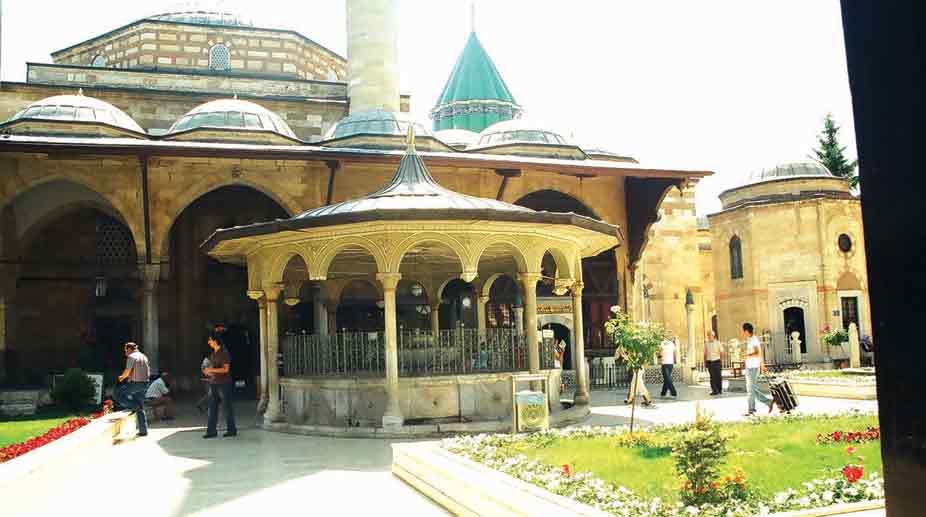Rumi: The inward mystic philosophy
Rumi, a 13th century (1207-1273) Muslim poet, jurist, theologian and Sufi mystic is regarded as one of the greatest Sufi spiritual masters and poets, famous for his epic Masnavi-i Manavi.
Mesmerised by the tranquil atmosphere of an ancient Sufi tomb in Turkey’s Konya city, Shalini Mitra felt closer to the divine at the Whirling Dervishes’ Festival.

Konya-mosque
Come December, I go back to Turkey, albeit in my thoughts. The memories of visiting Konya come flooding back around this time of the year. Thousands of people descend from all over the world on the Turkish city of Konya for a week-long (10-17 December) celebration of Rumi and the Whirling Dervishes’ Festival.
This was my first visit to Konya, a city south of Ankara in Turkey’s Central Anatolia region to attend the annual festival, which is one of the most important events in the whole of Turkey. Konya is a pilgrimage destination for Sufis and Mevlana Jelaleddin Rumi (1207- 1273) was an acclaimed Sufi and a poet from the 13th century, who lived and died in Konya. Followers of Rumi are called whirling dervishes.
A few days before visiting Konya, while exploring Istanbul, I had come across several hoardings and billboards advertising the Whirling Dervish performance in the Turkish Capital. While I did not pay much attention to it, dismissing it as one of those touristy things to do, a fellow tourist suggested (read insisted) that any trip to Turkey is incomplete without visiting Konya. It is a must-see attraction, particularly in December’s second week. Since Konya was just an hour’s flight away, I decided to visit the Anatolian city, also known as Turkey’s most culturally conservative city. I was joined by hordes of people (two million or so tourists visit annually) as I headed for the Sufi’s tomb inside the Mevlana Museum for a ceremony known as Semâ. The brochure that was handed to me by my guide Nurdogan read that Semâ is part of the inspiration of Mevlana Rumi as well as part of Turkish custom, history, beliefs and culture. Sufism expresses love of God in an ecstatic whirling dance.
Advertisement
The atmosphere was ripe with mysticism as the “dancers”, known as “whirling dervishes”, clad in black coat (which they shed later to reveal underneath a flowing white skirt) with cylindrical hats (hat represents a tombstone and the wide white skirt symbolizes the death shroud) and bowed heads, gathered in a large circle in the circular hall. The soft music of Ney (reed flute), strings and tambourines created a divine atmosphere. I noticed, as the dervishes bowed, they looked between the eyebrows of the dervish opposite them, which Nurdogan explained as contemplating the divine manifestation within. Gradually they started spinning like tops across the stage while seeming to be in a meditative stance. They twirled in perfect harmony as the mesmerized and an awestruck audience watched in pin-drop silence.
I could not help wondering what made these whirling dancers not feel dizzy as they incessantly spin and twirl in rhythm. Everything is about balance, I guessed. Nurdogan again explained that this is no ordinary dance.
Sacred ritual
Sema, meaning “to listen to the music”, is a sacred ritual of love. It represents a mystical journey propelled through the love of perfection and involving a spiritual ascent through the mind. Rumi had emphasised that music uplifts our spirit to realms above and we hear the tunes of the Gates of Paradise. Rumi preached love and respect for all, regardless of their religion. He taught inclusivity and tolerance. I understood a deeper meaning that whirling of a dervish is symbolic of the person, who grows through love, deserts the ego, finds the truth and arrives at perfection. Their whirling symbolizes the rotation of the universe in the presence of God. Nurdogan gave a meaningful explanation, “In a Sema, in the ecstasy, the Sufi finds God and peace by extending himself from the earth to the cosmos. He is aware of time by concentrating on his movements on all different velocities.”
Near the end, as the last part of the ceremony, the sheikh enters the circling dervishes, where he assumes the place of the sun in the centre of the circling planets. The dervishes returned side by side and knelt down. They put on black cloaks again to represent the material world. At the end of the hour-long performance everyone seemed to be in a deep meditative state. Like in other cultural performances, there was no photography, no video, and no applauding, at all. A serene silence prevailed. As the crowd walked out silently, I noticed some had Qurans in their hands and some had Rumi’s poetry. Some were so moved that they wiped their tears. I, too, felt elevated, as if my soul has been freed from the worldly affairs and had come closer to the divine.
The feeling of having attended a ceremony that is part of the Masterpieces of the Oral and Intangible Heritage of Humanity by UNESCO was quite satisfying. The 800-year-old tradition and ritual is now taught by many Turkish universities and cultural organisations as a way of preserving the history and transferring it on to the next generation. I shall visit Konya again, not in my thoughts, but in person.
Advertisement